THE HISTORY OF 3D RENDERING: The Pre-Digital Age. Part 2.
BASIC PRINCIPLES OF 3D MODELLING
Wires And Matrix Maths
The Technological Industrial Revolution (The 2nd Industrial Revolution) of the 1900s brought to life stunning discoveries in science and innovations in technology which drastically impacted 3D visualization methods. This include both technology aspects, e.g. the expanding usage of electricity, and scientific aspects, e.g. the occurrence of matrix mathematics, basic principles of which are fundamental for contemporary 3D modelling.
A Name
Arthur Cayley (16 August 1821 – 26 January 1895) was a British mathematician, developer of matrix mathematics, which is fundamental for modern computer graphics.
THE EARLIEST DIGITAL PICTURES
The First Photo-Electric Pictures
In 1881 a British researcher Shelford Bidwell introduced his invention – the method of telephotography. His initial idea was to transmit visual images by means of discreet electrical impulses. The functioning of the apparatus, constructed by Bidwell, was based on the properties of a chemical element Selenium to change electrical resistance under direct light. The transmitter scanned a picture line by line and sent the intermittent electrical signals down the telegraph wire to the receiver, where the image was recreated.
The pictures and the apparatus are housed in the collection of the Science Museum in London.
A Name
Shelford Bidwell (6 March 1848 – 18 December 1909) was a British scientist and inventor. He developed the method of telephotography, by means of which pictures were transmitted as digital information.
Under The Sea
Bartlane cable picture transmission system was developed in 1920 by two British researches Harry G. Bartholomew and Maynard D. McFarlane to transmit digitized newspaper pictures from London to New-York over trans-Atlantic submarine cable lines. Special printing devices at the transmitter transformed a film negative into a punched data telegraph tape and special printers at the receiver recreated the initial image.

STUNNING PROGRESS IN AXONOMETRIC DRAWINGS
Bauhaus
The next breakthrough in visualization was connected with the famous art and design school Bauhaus. The school opened in 1919 in Germany. The main principle of the Bauhaus design was to expand style and quality to every house. Functional reduced forms in exterior and interior design and economic geometrical shapes of furniture made axonometric drawings with vanishing points available for understanding even by amateurs. Although made by hand, the master visualizations of three-dimensional spaces at Bauhaus gradually led 3D rendering to become an integral part and an essential tool in architecture and other fields such as industrial design, showcase design, furniture design. Still axonometric manual drawing took really long to be accomplished – years sometimes - and the changes in the field became quite essential.

A Name
Walter Adolph Georg Gropius (15 May 1883 – 5 July 1959) a German-American architect, who was a trailblazer of modernist architecture and a founder of the Bauhaus school in Weimar in 1919. The door handle, designed by Gropius in 1923, became an icon of design in 1900s and has remained one of the most significant designs, originated from Bauhaus.


